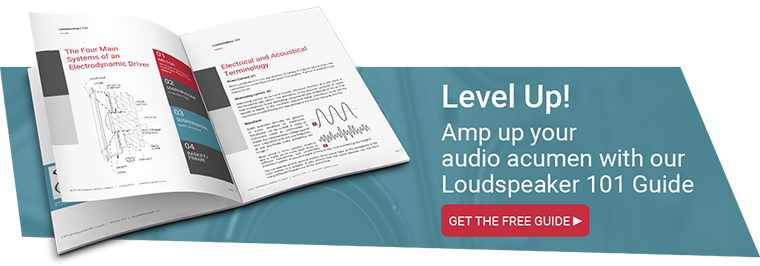How to Deal with Harmonic Distortion in Speaker Design
Designing a loudspeaker to go inside your finished product, be it a car, an airplane, a casino game, or anything else, you have to make tradeoffs around price, size, weight, and performance. Of course, you need your speaker to reach a certain level of sound quality. One way to measure this is total harmonic distortion (THD). But is that the best way?
Harmonic Distortion
Harmonic distortion is just one of the many kinds of distortion that must be addressed in speaker design. It specifically deals with when the fundamental signal at one frequency going into a speaker is reproduced at a multiple, or harmonic, of that frequency. For example, you feed a 1 kHz signal into a speaker and the output includes that tone, plus harmonics at 2 kHz, 3 kHz, and so on (these are called the 2nd order harmonics, 3rd order harmonics, and so on). The harmonics should be quieter than the input signal. Odd ordered harmonics (3rd, 5th, etc.) are more jarring to our ears than the even ordered harmonics. Some harmonic distortion is so quiet human ears can not even perceive it. So how much does it matter?
The amount of harmonic distortion changes with each frequency. A speaker may create unwanted harmonics at certain frequencies and not at others. This is why it’s important to communicate with your speaker manufacturer about the intended application for your speaker so they can test it meticulously within the frequency range that it will be used.
The level of harmonic distortion can be expressed either as a percentage or in dB relative to the input signal. For example, 1% distortion is equal to about -40 dB quieter than the input signal. The way you calculate THD is by figuring the amount of distortion at each point along the speaker’s frequency response.
As a general rule of thumb, you want to have a THD that is less than 2% within your speaker’s intended frequency response range. However, there is not a universally accepted standard for performing these tests. This is one reason THD should not be your only metric for assessing whether a speaker can do what you need it to.
Along with being frequency-dependent, harmonic distortion also is impacted by the strength of the signal being fed into the speaker. This makes common sense; as you turn a speaker up it approaches its performance limits. It begins to lose sound quality and you can hear the distortion increasing (this is a combination of THD and intermodulation distortion).
Distortion can have a very important role in the preservation of speaker systems because it is a warning that your speaker is in danger of burning out. The bad sound of distortion can deter people from turning it up more, even if they don’t understand why they shouldn’t. Distortion also gives people a sensation of loudness psychoacoustically.
Causes and Solutions For Harmonic Distortion
Harmonic distortion is caused by any part of a speaker not working linearly. It could be imperfections in the voice coil, the cone, or another part of the transducer. Addressing these are part of the decision-making process when considering performance, cost, and size compromises.
Today, using high-tech Klippel Analyzers we can essentially see inside of a speaker and tell what is happening at specific frequencies. This is a very powerful tool for diagnosing distortions, including harmonic distortion.
In general, a lower THD is a strong indicator of a higher-quality speaker. However, it is not the end-all-be-all and should be considered alongside other speaker specifications when conducting R&D on a new speaker design. You can tell a transducer engineer to deliver a speaker with no harmonic distortion (or as close to none as humanly possible) but that speaker will be too big and costly for almost any useful purpose. Instead, to get a speaker that meets your needs and your budget, a transducer engineer should focus on the parameters for your specific application.
Maintaining Quality Control
Designing a prototype that meets your needs is just one step to fulfilling your order. It’s important that each individual unit is tested before it is shipped. The most effective way to do this is with end-of-line testing that includes using SoundCheck by Listen.
By running various stimuli (signals) through the speaker, SoundCheck will confirm the finished product has the intended frequency response, THD, impedance, etc. Different stimuli are suited for exposing different symptoms.
Another distortion measurement that is done is called rub and buzz. These are extra noises that are not necessarily harmonic in nature but can be. Non harmonically related noises would be considered impulsive in nature.
Impulsive distortion is not a predictable or modellable symptom as it can appear and disappear randomly and could be caused by something as small as a grain of sand within the transducer or a bit of the cone adhesive not sealing properly. Metal chips are the worst as they are attracted to the magnetic gap. These we would call buzzes. Rubs would be something like the voice coil hitting or sliding on things it is not supposed to.
Rub and buzz issues are of the highest priority as these cause customer returns and damage to reputations. Rub and buzz are the easiest defects to notice, especially for people who are not trained or experts in acoustics. These will eventually cause a hard failure in the speaker too.
This critical end-of-line test is the best way to ensure quality control and that each speaker you get meets the parameters it was originally designed for.

